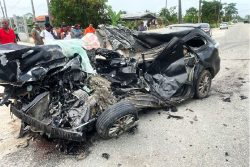Local efforts made to retrieve the scanned images of the container found with 11.5 tonnes of cocaine by Belgian authorities have so far proven futile, Customs Anti-Narcotic Unit (CANU) head James Singh says.
When contacted, Singh told Stabroek News that an independent forensic audit was conducted in a bid to retrieve the scanned images but it was unsuccessful. Every possible option was explored during the audit to recover the images, he assured.
Sources close to the investigation had told Stabroek News that the container was scanned but it appears as though the Guyana Revenue Authority (GRA) images from the scanner were altered or deleted.
Singh had previously told Stabroek News that five containers were scanned on the day in question but the GRA had only provided images from four of the five containers.
Almost two weeks ago, law enforcement officials in Belgium announced that they were probing the discovery of 11.5 tonnes of cocaine in the container of scrap metal shipped from Guyana.
The shipment, which has been described as “the largest overseas drug bust ever, worldwide,” was seized upon its arrival at the Port of Antwerp. It carries an estimated street value of 900 million Euros.
The Brussels Times had reported counter-narcotics prosecutors as saying that they tracked the transatlantic journey of the cocaine from Guyana following the dismantlement of a drug trafficking gang led by a former Belgian counter-narcotics chief, which revealed the existence of tight-knit links between criminal gangs and counter-narcotics and law enforcement officials.
It is suspected that the images were either deleted or altered by law enforcement officials who were on duty at the port on the day when the shipment departed Guyana.
Stabroek News was previously informed that the shipment departed Guyana on September 25th and was searched by Belgian authorities on October 27th.
To date, a number of persons including employees of the GRA, have been questioned in relation to the discovery and have since been released. However, a number of persons are required to report to CANU on a daily basis as the investigation continues.
Both CANU and the police have since issued a wanted bulletin for the shipper of the container, Marlon Primo. It is believed that Primo has crucial information that can aid in the probe.
A number of searches were conducted in a bid to apprehend Primo but he was not located.
Singh had said that the agency reached out to Primo’s family seeking assistance on his whereabouts and to ask him to surrender. He had also said that if safety is a concern for Primo, CANU is willing to provide protection for him.
Singh explained that while the scanned images would have been “added proof” in the case, the investigation has not been stalled.
He said local authorities are continuing to engage their counterparts overseas. “We have been sharing information as it relates to the persons involved on the receiving end and links here also,” he noted.
‘Deliberate collusion’
According to Singh, the fact that attempts were made to delete the images, which normally captures the entire processing operation at the ports, means that there is “deliberate” collusion.
He said this has to be addressed.
Singh added that GRA is aware of the issue and it is being addressed by management.
The intercepted shipment has once again raised questions about the processing of the containers before they depart Guyana.
Last Monday, Minister of Home Affairs Robeson Benn told reporters that the authorities are “extremely” alarmed that the shipment passed through the surveillance system without being discovered. He had said that the operation had to have been in the planning for months.
Singh further related that this is not the first instance whereby law enforcement officials encountered such an experience.
In August, authorities in the German port city of Hamburg found over €300 million worth of cocaine in a cargo ship container from Guyana containing rice. The cocaine, which weighed 1.5 tonnes, was found in a freight container. It is believed that the drug was inserted in the Dominican Republic, where the vessel stopped before the cargo was taken to Hamburg.
Singh added that the scans were also deleted for that shipment. Moreover, CANU’s investigations have revealed that the same staff members were on duty when both shipments in question were processed.
As a result, following his reappointment as head of CANU, Singh said he has ordered a new probe into the Hamburg discovery.









